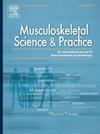The EMU manipulation study: A randomized trial investigating the efficacy of matched or unmatched cervical/thoracic manipulations on neck pain
IF 2.2
3区 医学
Q1 REHABILITATION
引用次数: 0
Abstract
Introduction
Neck pain is common, and cervical and thoracic thrust joint manipulation are recommended treatments. The Cervical Thoracic Differentiation Test (CTDT) is proposed to differentiate pain of cervical or thoracic origin, but its value in guiding choice of manipulation remains unclear. This study aimed to evaluate the utility of the CTDT in selecting treatment for non-specific mechanical neck pain.
Methods
A quadruple-blinded, two-arm randomized trial enrolled adults aged 18–65 with neck pain ≥3/10. Forty participants completed the Neck Disability Index (NDI), cervical ROM (ROM), VAS for pain (rest and movement), and CTDT. They were equally allocated to a single session of either matched or unmatched manipulation based on CTDT results. Pain and ROM were assessed immediately post-manipulation and 38 participants were assessed at a one-week follow-up.
Results
Forty participants (mean age 24.8 ± 9.9 years, 51.2 % female) were included. Significant differences in the primary outcome of pain with movement were found across all time points (F2, 72 = 60.455, p < 0.001). Significant pain reductions were observed from pre-manipulation to immediately post-manipulation and continued at one-week. There were no differences between matched/unmatched manipulations at either time point (p > 0.05). There were no significant differences in pain at rest, NDI scores, or ROM changes between groups.
Conclusions
Both matched and unmatched manipulations significantly reduced pain with movement, with no differences based on CTDT results. In the context of a rigorously blinded trial, cervical and thoracic manipulations appear to be equally efficacious for managing neck pain regardless of CTDT outcomes, although clinical outcomes may differ.
EMU操作研究:一项随机试验,调查匹配或不匹配的颈/胸操作对颈部疼痛的疗效
颈部疼痛是常见的,颈椎和胸椎关节按摩是推荐的治疗方法。颈胸椎鉴别试验(CTDT)被提出用于鉴别颈或胸源性疼痛,但其在指导手法选择方面的价值尚不清楚。本研究旨在评估CTDT在选择非特异性机械性颈痛治疗方法中的效用。方法采用四双盲、双臂随机试验,招募年龄在18-65岁、颈部疼痛≥3/10的成年人。40名参与者完成了颈部残疾指数(NDI)、颈椎ROM (ROM)、疼痛VAS(休息和运动)和CTDT。他们被平等地分配到一个基于CTDT结果的匹配或不匹配操作的会话中。操作后立即评估疼痛和关节活动度,38名参与者在一周的随访中进行评估。结果共纳入40例,平均年龄24.8±9.9岁,女性占51.2%。各时间点疼痛伴运动的主要结局存在显著差异(F2, 72 = 60.455, p <;0.001)。从操作前到操作后立即观察到明显的疼痛减轻,并持续一周。在任何时间点,匹配/不匹配操作之间没有差异(p >;0.05)。两组间在静息疼痛、NDI评分或ROM变化方面无显著差异。结论配合和不配合手法均可显著减轻运动疼痛,CTDT结果无差异。在一项严格的盲法试验的背景下,尽管临床结果可能不同,但无论CTDT结果如何,颈椎和胸椎手法似乎对治疗颈部疼痛同样有效。
本文章由计算机程序翻译,如有差异,请以英文原文为准。
求助全文
约1分钟内获得全文
求助全文
来源期刊

Musculoskeletal Science and Practice
Health Professions-Physical Therapy, Sports Therapy and Rehabilitation
CiteScore
4.10
自引率
8.70%
发文量
152
审稿时长
48 days
期刊介绍:
Musculoskeletal Science & Practice, international journal of musculoskeletal physiotherapy, is a peer-reviewed international journal (previously Manual Therapy), publishing high quality original research, review and Masterclass articles that contribute to improving the clinical understanding of appropriate care processes for musculoskeletal disorders. The journal publishes articles that influence or add to the body of evidence on diagnostic and therapeutic processes, patient centered care, guidelines for musculoskeletal therapeutics and theoretical models that support developments in assessment, diagnosis, clinical reasoning and interventions.
 求助内容:
求助内容: 应助结果提醒方式:
应助结果提醒方式:


